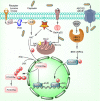Emerging targets in cancer drug resistance
- PMID: 35582722
- PMCID: PMC8992633
- DOI: 10.20517/cdr.2018.27
Emerging targets in cancer drug resistance
Abstract
Drug resistance is a complex phenomenon that frequently develops as a failure to chemotherapy during cancer treatment. Malignant cells increasingly generate resistance to various chemotherapeutic drugs through distinct mechanisms and pathways. Understanding the molecular mechanisms involved in drug resistance remains an important area of research for identification of precise targets and drug discovery to improve therapeutic outcomes. This review highlights the role of some recent emerging targets and pathways which play critical role in driving drug resistance.
Keywords: Drug resistance; FOXO transcription factors; Keap1-Nrf2; MIEN1; PI3K-Akt; annexins; focal adhesion kinases; gene splicing; microRNA; sphingolipids; transforming growth factor-β.
© The Author(s) 2019.
Conflict of interest statement
All authors declared that there are no conflicts of interest.
Figures



Similar articles
-
Genetic alteration of Keap1 confers constitutive Nrf2 activation and resistance to chemotherapy in gallbladder cancer.Gastroenterology. 2008 Oct;135(4):1358-1368, 1368.e1-4. doi: 10.1053/j.gastro.2008.06.082. Epub 2008 Jul 3. Gastroenterology. 2008. PMID: 18692501
-
Roles of the RAF/MEK/ERK and PI3K/PTEN/AKT pathways in malignant transformation and drug resistance.Adv Enzyme Regul. 2006;46:249-79. doi: 10.1016/j.advenzreg.2006.01.004. Epub 2006 Jul 18. Adv Enzyme Regul. 2006. PMID: 16854453
-
Role of FOXO protein's abnormal activation through PI3K/AKT pathway in platinum resistance of ovarian cancer.J Obstet Gynaecol Res. 2021 Jun;47(6):1946-1957. doi: 10.1111/jog.14753. Epub 2021 Apr 7. J Obstet Gynaecol Res. 2021. PMID: 33827148 Review.
-
Therapeutic resistance resulting from mutations in Raf/MEK/ERK and PI3K/PTEN/Akt/mTOR signaling pathways.J Cell Physiol. 2011 Nov;226(11):2762-81. doi: 10.1002/jcp.22647. J Cell Physiol. 2011. PMID: 21302297 Review.
-
FOXO Signaling Pathways as Therapeutic Targets in Cancer.Int J Biol Sci. 2017 Jul 6;13(7):815-827. doi: 10.7150/ijbs.20052. eCollection 2017. Int J Biol Sci. 2017. PMID: 28808415 Free PMC article. Review.
Cited by
-
Cytotoxic naphtho- and benzofurans from an endophytic fungus Epicoccum nigrum Ann-B-2 associated with Annona squamosa fruits.Sci Rep. 2024 Feb 28;14(1):4940. doi: 10.1038/s41598-024-55168-5. Sci Rep. 2024. PMID: 38418706 Free PMC article.
-
Drug resistance mechanisms in cancers: Execution of pro-survival strategies.J Biomed Res. 2024 Feb 28;38(2):95-121. doi: 10.7555/JBR.37.20230248. J Biomed Res. 2024. PMID: 38413011 Free PMC article.
-
The Pathogenic Role of PI3K/AKT Pathway in Cancer Onset and Drug Resistance: An Updated Review.Cancers (Basel). 2021 Aug 5;13(16):3949. doi: 10.3390/cancers13163949. Cancers (Basel). 2021. PMID: 34439105 Free PMC article. Review.
-
Understanding the Combined Effects of High Glucose Induced Hyper-Osmotic Stress and Oxygen Tension in the Progression of Tumourigenesis: From Mechanism to Anti-Cancer Therapeutics.Cells. 2023 Mar 7;12(6):825. doi: 10.3390/cells12060825. Cells. 2023. PMID: 36980166 Free PMC article.
-
FoxO3a Inhibits Tamoxifen-Resistant Breast Cancer Progression by Inducing Integrin α5 Expression.Cancers (Basel). 2022 Jan 2;14(1):214. doi: 10.3390/cancers14010214. Cancers (Basel). 2022. PMID: 35008379 Free PMC article.
References
-
- Goodman LS, Wintrobe MM, Dameshek W, Goodman MJ, McLennan MT, et al. Nitrogen mustard therapy: the use of methyl-bis(β-chloroethyl) amine hydrochloride and tris(\sb-chlorethyl) amine hydrochloride for Hodgkin’s disease, lymphosarcoma, leukemia, and certain allied and miscellaneous disorders. JAMA. 1946;132:126–32. doi: 10.1001/jama.1946.02870380008004. - DOI - PubMed
Publication types
LinkOut - more resources
Full Text Sources
